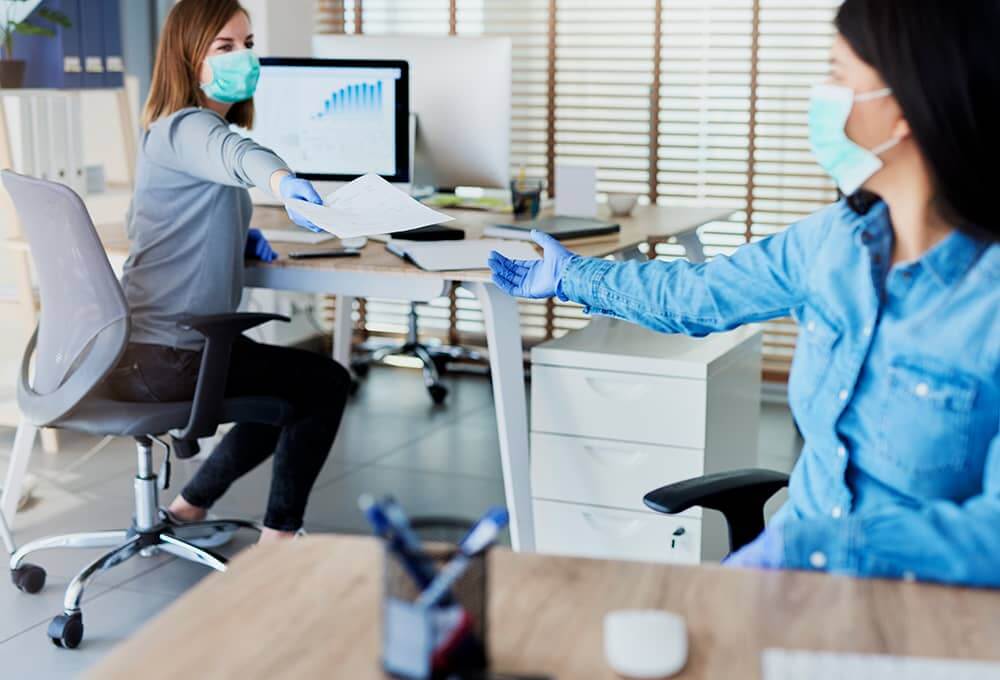
Reading Time: minutes
Many companies are now polishing their business re-entry plans and programs as they prepare their back to the office strategies. After seven months under the lockdown, the government is finally easing restrictions and allowing more business sectors to operate amid the pandemic.
With the guidance of the Inter-Agency Task Force for the Management of Emerging Infectious Diseases (IATF), the Department of Trade and Industry (DTI) has recently allowed additional industries to resume operations to full capacity under the general community quarantine.
RELATED: Full Capacity for Enterprise: What does this mean for the Philippines?
Reports from the Department of Labor and Employment (DOLE) in September concluded that the easing of quarantine restrictions enabled the restoration of 7.5 million jobs and the return to productive work of 4.9 million workers compared to when Enhanced Community Quarantine (ECQ) was implemented in March. 
Return to a safe workplace
Working from home can be productive for some, but most people want to return to the workplace—given that it is safe and secured from the threats of an outbreak. Others argue that remote working is not a long-term business solution in the Philippines as the country is ‘not work from home-friendly'.
READ MORE: Working from Home in the Philippines: Why Remote Working is Not a Long-term Business Solution
While some local companies are considering allowing their employees to telework indefinitely, many are future-proofing the workplace to ensure the health and safety of their employees who are returning to the office even with the threats of COVID-19 still present. Gensler, an international design and architecture firm, published a report that discussed three incremental shifts that employers can consider to gain the confidence of their workforce in returning to the office.
According to the firm, these shifts are not only to transition into the new normal but also to prepare and for the long-term future of work:
| Focus on Health |
|
| Leading the Change |
|
| The Reimagined Workplace |
|
The government, through DOLE, also noted that it will aid the economic transition into the new normal by the implementation of the “Prevent, Detect, Isolate, Treat, and Recover.” (PDITR) strategy to help private firms and businesses mitigate return to the office risks.
DOLE also urged companies to consider adopting one or two of the following temporary alternative working schemes to lessen the risk of office transmission and cross-infection:
- Transfer of employees to another branch or outlet;
- Assignment of employees to another function or position in the same or other branch or outlet of the same employer;
- Reduction of normal workdays per day or week;
- Job rotation alternately providing workers with work within the workweek or the month;
- Partial closure of the establishment; and
- Other feasible work arrangements

Hybrid Reality
Workplace strategists and designers predict that companies who will implement back to the office strategies will enter a “bridge” phase until circumstances become more stable. Building owners, property managers, and employers could take several short-term actions to make employees feel safer to work in the office such as rethinking meeting spaces, implementing building-wide cleaning protocols, focusing on indoor air quality, and updating safety measures.
LEARN MORE: Pandemic-proof Workplace: How LEED Buildings Stand Out
Companies are also implementing policies to ensure physical distancing in the office. Employees are seated farther away from each other, spacing them further apart. Some are also utilizing a shifting workforce scheme that effectively reduces the number of employees inside the office during specific work hours.
Shared and common spaces such as meeting rooms, conference rooms, lounges, and the pantry are also closely monitored to ensure that employees remain socially distanced from each other and prevent a virus outbreak in the workplace.
To effectively “de-densify” the office, companies could let a certain percentage of their employees to come back to the office and let the other continue working remotely. It is advised to gradually increase this percentage as businesses gain more confidence in the safety of the work environment.
Need more business re-entry ideas for your company? Contact us today! Reach out to Joseph Drage at (+63) 917-811-5853. You may also call us at (+63) 2-8403-5519 or send an email to [email protected].


